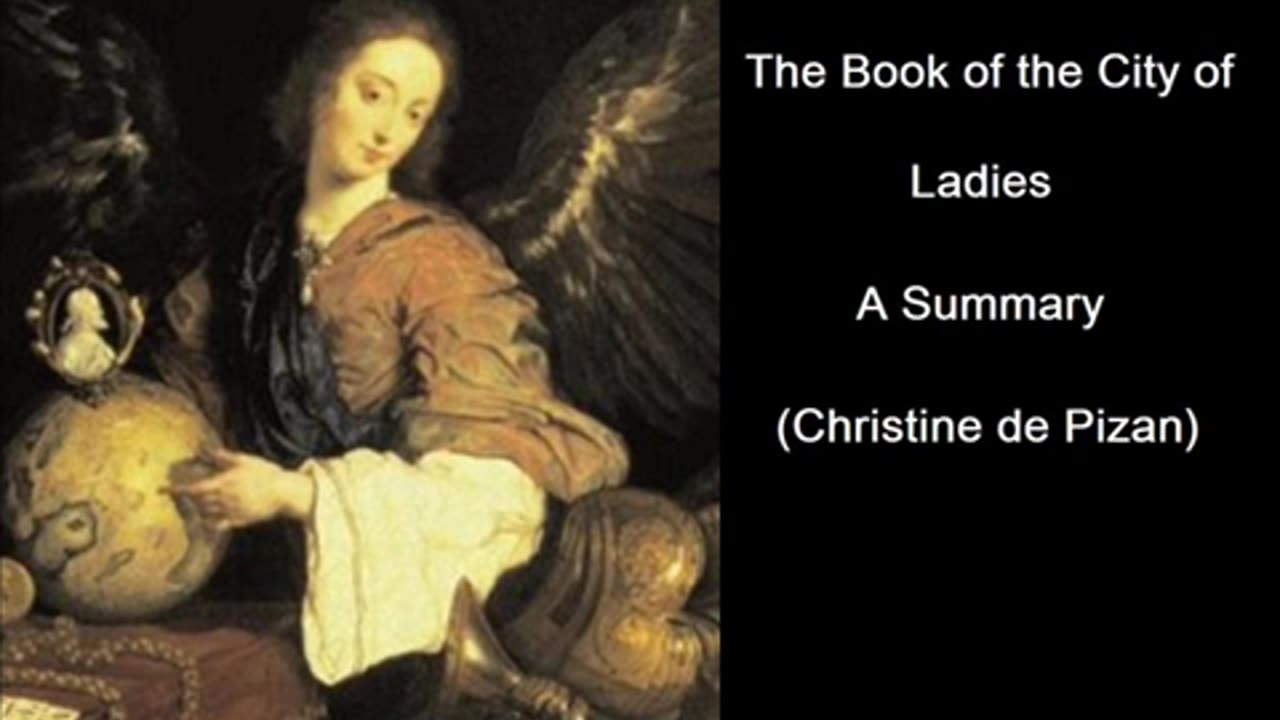Premium Only Content

Summary: The Book of the City of Ladies (Christine de Pizan)
"The Book of the City of Ladies" (French: "Le Livre de la Cité des Dames") is a medieval work written by Christine de Pizan, a prominent Italian-French writer who lived from 1364 to 1430. This book is considered one of the earliest works of feminist literature and a significant contribution to medieval literature.
Summary:
Introduction and Context:
Christine de Pizan, a prolific Italian-French writer of the late 14th and early 15th centuries, opens the book with a lament about the state of women in her society. She is troubled by the prevailing misogyny and the negative portrayal of women in literature and philosophy.
The Dream Vision:
The book takes the form of a dream vision, a popular literary device of the time. In Christine's dream, she is visited by three allegorical figures: Lady Reason, Lady Rectitude, and Lady Justice. These figures serve as guides and mentors throughout the narrative.
The Building of the City:
Under Lady Reason's guidance, Christine embarks on the task of constructing an imaginary city, the "City of Ladies." This city is to be a sanctuary for virtuous women, a place where their worth and accomplishments are celebrated.
The foundation stones of the city are metaphorically constructed from stories and examples of accomplished women from history, mythology, and literature. Each stone represents a woman of great virtue and achievement. These women include figures from antiquity, the Bible, and medieval Europe.
Notable Women in the City:
Christine de Pizan highlights several notable women who inhabit the City of Ladies, including:
Queen Semiramis: An Assyrian queen known for her military and architectural achievements.
Hypatia: An ancient Greek mathematician, philosopher, and astronomer.
Joan of Arc: The famous French heroine who led her country's army during the Hundred Years' War.
The inclusion of these women serves to challenge the prevailing notion that women are inherently inferior or incapable of significant accomplishments.
Discussions on Women's Abilities and Virtues:
As the city takes shape, Lady Reason, Lady Rectitude, and Lady Justice engage in discussions with Christine. They address various aspects of women's roles, abilities, and contributions to society.
Christine argues passionately for women's education, contending that women are not naturally less capable than men but are hindered by a lack of access to learning and opportunities.
The book emphasizes that women can excel in diverse fields, including the arts, sciences, leadership, and philosophy, if they are given the chance.
Rejection of Misogynistic Stereotypes:
Throughout the work, Christine de Pizan actively refutes and rebuts misogynistic stereotypes and negative beliefs about women that were prevalent during her era.
She emphasizes the importance of recognizing and celebrating women's achievements and virtues, pushing back against the prevailing attitudes that sought to marginalize and denigrate women.
Conclusion:
"The Book of the City of Ladies" by Christine de Pizan is a powerful and groundbreaking work of feminist literature. It constructs an allegorical city as a symbol of women's worth, capabilities, and contributions.
The book challenges the deeply entrenched patriarchal attitudes of the time and champions the idea that women, like men, have the potential for greatness and virtue.
This work remains a significant text in the history of feminism, gender studies, and medieval literature. It offers valuable insights into the evolving role and status of women in medieval society and serves as a timeless testament to the capabilities of women.
-
 2:00:53
2:00:53
MG Show
19 hours agoTrump Stops the Epstein Nonsense & Exposes FAKE MAGA; Victory Lap
67.3K58 -
 39:21
39:21
MattGaetz
1 day agoThe Anchormen Show with Matt Gaetz | Feeding the Dragon
22.7K20 -
 6:01
6:01
Michael Button
2 days ago $1.35 earnedMy History Degree Lied About Lost Civilizations
29.3K13 -
 9:36
9:36
MattMorseTV
1 day ago $3.84 earnedThe EU just FOUND OUT.
16.2K46 -
 22:39
22:39
Forrest Galante
1 day agoPrivate Tour of Australia's Craziest Zoo
149K13 -
 6:57:31
6:57:31
ABNERDAGREAT
8 hours ago🔴DISCORD VC/MUSIC ZELDA BREATH OF THE WILD SWITCH 2 EDITION🔴
4.96K1 -
 1:06:42
1:06:42
The Connect: With Johnny Mitchell
3 days ago $23.49 earnedTruth About The Epstein Files: CIA Agent Reveals The Connection Between The Mossad, Epstein, & Trump
69.2K84 -
 1:59:00
1:59:00
Side Scrollers Podcast
20 hours agoSuperman Movie MELTDOWN, FBI SEIZES Game Websites, Elmo Gets HACKED | Side Scrollers Live
15.8K5 -
 LIVE
LIVE
Welsh Girl
10 hours ago🔴 Is WoW Getting Worse or Better? Day 5
158 watching -
 6:56:18
6:56:18
RECON-RAT Guns & Gaming
2 days ago $0.05 earnedRECON-RAT - ARMA Reforger WWII - Testing new mod!
4.05K1